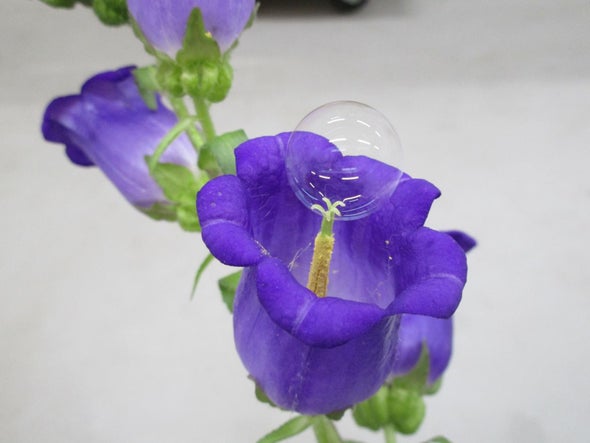(单词翻译:单击)
听力文本
This is Scientific American's 60-second Science. I'm Karen Hopkin.
Bees are a big part of the life cycle of plants, carrying pollen from one flower to another and allowing plants to produce their frequently yummy output. But with bee populations on the decline, what can take their place? How about soap bubbles?
It may sound fantastical. But Eijiro Miyako and his colleague at the Japan Advanced Institute of Science and Technology have used battery-powered bubble makers to pollinate a pear orchard. The details of their magical realism approach to agriculture are in the journal iScience.
A few years back, Miyako and his team tried to mimic the pollinating prowess of honeybees by retrofitting a two-inch-long toy drone with brushes made of horsehair. They loaded the device with pollen suspended in a sticky gel. But the tiny flyer was tough to control. And its hairy little applicators ended up damaging the delicate floral targets.

After spending some time blowing bubbles with his son, Miyako started thinking more seriously about these soapy little marvels. He figured bubbles would be sticky enough to carry and deliver a pollen payload but soft and flexible, so they shouldn't hurt a blossom when they land and then pop.
The researchers chemically optimized their soapy solution to make bubbles that were mechanically stable and actually enhanced the pollination process.
Out in the orchard, they aimed their souped-up soap bubbles at row after row of pear trees. And they found the bubble system worked just as well as the more labor-intensive pollination by hand: pear trees pollinated by bubble ultimately bore fruit—a sweet sign of success.
Miyako has also revived the drone program—this time using a larger model—equipped with a machine that unleashes a bubble blitz. And has a big advantage over the hand-held model...
"Because it's fully autonomously controllable by GPS with Google Map."
So the drones can make a beeline to where farmers need them, you know, to be.
Thanks for listening for Scientific American's 60-second Science. I'm Karen Hopkin.
参考译文
这里是科学美国人——60秒科学。我是凯伦·霍普金。
蜜蜂是植物生命周期的重要组成部分,它们将花粉从一朵花传到另一朵花上,让植物经常性地生产出美味。但随着蜜蜂数量的下降,什么能取代它们的位置呢?肥皂泡怎么样?
这听起来可能不可思议。但是,北陆先端科学技术大学院大学的都英次郎和同事使用电池供电的泡泡机为梨园授粉。他们的魔幻现实主义农业方法的细节刊登在《科学》期刊上。
几年前,都英次郎和团队用两英寸长的玩具无人机加装马毛刷子,以尝试模仿蜜蜂的授粉能力。他们在设备上安装了悬浮在粘性凝胶中的花粉。但这个种微型飞行器很难控制。其小型马毛敷抹器最终破坏了娇弱的花朵目标。
在花了一段时间和儿子玩吹泡泡之后,都英次郎开始更认真地思考这些肥皂小奇迹。他认为泡泡有足够的粘性来携带和传递花粉载荷,但又柔软而且有弹性,所以泡泡落下后爆开时应该不会伤害花朵。
研究人员用化学方法优化了他们的肥皂溶液,使之产生机械稳定的气泡,从而增强授粉过程。
在果园里,他们将增强版肥皂泡对准一排又一排的梨树。他们发现,泡泡系统的效果与劳动更加密集的人工授粉一样好:用泡泡授粉的梨树最终结出了果实——这是甜蜜的成功信号。
都英次郎还重启了无人机项目——这次使用了更多的大型,配备了能释放泡泡突击的机器。而且相比手持模型,它拥有巨大的优势……
“因为它可以完全由谷歌地图通过GPS自主控制。”
因此,无人机可以飞到农民需要的地方。
谢谢大家收听科学美国人——60秒科学。我是凯伦·霍普金。
译文为可可英语翻译,未经授权请勿转载!
重点讲解
重点讲解:
1. take sb's place 取代;
Who's going to take his place after he leaves?
他走了谁来顶替他?
2. how about (用于引出相关的新话题)怎么样,如何;
Are your products and services competitive? How about marketing?
你们的产品和服务有竞争力吗?营销又怎么样呢?
3. end up 最终;结果;到头来;
If you fool about with matches, you'll end up getting burned.
如果你摆弄火柴,最后可能烧到自己。
4. make a beeline 径直前往;直奔;
He made a beeline to the bar after work.
一下班,他就直奔酒吧。


